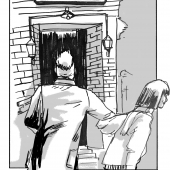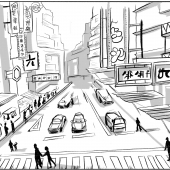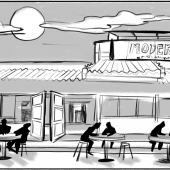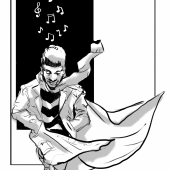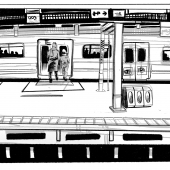Sitting in my middle seat approaching my home away from home – Beijing. I can hear the humming of the plane’s engines singing memories of the hustle and bustle that rings through sleepless hutongs (hútòng – alley, lane).
These hutongs are home to some of the best live music and nightlife available in Beijing. Like a maze of rock and jazz symphonies intertwined, the music can be heard from Houhai winding all the way through to Gulou and on to Dongzhimennei.
An amazing distance that stretches more than two kilometres. This historic area can be considered a getaway within the heart of a modern metropolitan city.
Come with me on a journey through her streets of entertainment.
Approaching the embankment of Houhai, each bars’ lights gleam down onto the river’s surface, painting a reflection so enchanting that it lures you in to marvel at its serene yet dynamic atmosphere.
A vivid reminder of St. Lawrence Gap (but on steroids!). Close by, there is a cozy little bar, which no one would imagine has been home to some of the best jazz artists from around the world, the East Shore Live Jazz Café. Tonight happens to be no different in the calibre of performers; pianist, Jeff Lorber has brought along Jimmy Haslip (left-hand bassist formerly of Grammy Award-winning jazz band, Yellowjackets) to perform some of his greatest hits as well as those from his new 2018 Grammy Award-winning album, Prototype.
However, because it was scheduled for a later start, we weave our way on through hutong world to see what more delights it has to offer and slip on into the connecting Gulou Ave.
Gulou Ave. has been around since ancient times, built in 1272 during the rule of Kublai Khan. Gulou gets its name from the drum tower (gu – drum, lóu – building, tower), which was first used for music, and then gradually went on to become a timekeeping piece for inner-city Beijing. Being a part of a modern and ever-changing city, Gulou now has subway access and an influx of expats willing to purchase musical equipment during the day and hear the harmonious tunes and rhythms that exude from each bar or livehouse (visible or hidden).
Similar to the Oistins Friday night experience, street vendors can also be seen selling all types of items, from arts and craft to an array of Chinese street food.
Gulou is made up of many small hutongs and our next stop is Baochao Hutong. As you slowly enter this hutong it feels like entering into a back alley around Marhill Street, Bridgetown; nevertheless, there are no “one-arm bandits” on these streets (game slot machines are colloquially known as “one-arm bandits”).
Deep within this hutong sits a gem known as Modernista. Modernista started out seven years ago as a small bar with checkered floors and a 1930’s European-style vibe. At that time, one could witness countless patrons, both foreigners and locals alike, flocking to hear all different genres of music and stand-up comedy performances. Sometimes it was so full that the excitement would spill over into the streets causing congestion with an air of carnival. Was it just the performances that had patrons so hooked?
I would say it was more because of the ambience – inside and out! In addition, there were and still are many other special events, such as live drawing, games, movies, lectures, just to name a few. Within the past few years, the performance stage has migrated to the adjacent building.
The entrance to the performance area is cleverly tucked away, leading into the Gulou’s underground. Patrons actually walk through the bar and up the stairs in the back to emerge through a tunnel- like entrance onto a patio overlooking the room below.
As the door eases open, you can hear all different jazz tunes filling the room. The atmosphere is lit similar to that of a Chicago or New Orleans back room jazz parlour. Entering from the balcony, you have a full view of the band swinging and the audience soaking up every note that soars across the room. It’s funny how, as jazz in the western hemisphere has developed into many different subgenres and fusions, Chinese musicians seem to stay true to the very traditional elements of this art form. It reminded me of the recent wave of jazz students emerging from the Barbados Community College. After a few major 7th’s and minor 9th‘s, we diminished into the streets of Gulou. Next stop is the East Shore Live Jazz Café. Climbing the stairs to get into East Shore, the entrance is lost by a trail of exuberant patrons. We finally squeeze through a sea of people and listen attentively to the finger gymnastics of Jimmy Haslip. His solo has this Chinese audience fully engaged with every slide, slap, and pluck of the bass.
I too am left speechless. As Jimmy throws the baton on to Jeff, Mr. Lorber truly shows us why the name of the band is Jeff Lorber Fusion. He delivers a solo with cool melodious lines and sound technique. To complete this band is a Chinese drummer, Beibei, who is certainly deep “in the pocket”. Each groove is totally locked right in. Never have I seen East Shore so alive. Not a square inch is left for standing or sitting. Cameras are glued to the performance with mesmerizing lenses. I try to raise my hand high over the crowd to get my last snippet, before dipping back out onto the streets of Gulou. Sadly, we have to leave early to ensure that our subway ride does not leave without us. This certainly isn’t like my beloved Bim’s ZR service: “Black Rock with seats and moving, Families!” As I walk away, the melodies of Gulou stay etched within my memory, playing repeatedly.
I am left jealous by the patrons who keep on coming, as I hurry to get that last subway train. Nevertheless, a broad smile on my face is definitely a sign of a contented music connoisseur.
Thank you for coming on this journey with me, through one of Beijing’s treasures, locked deep within her core.

